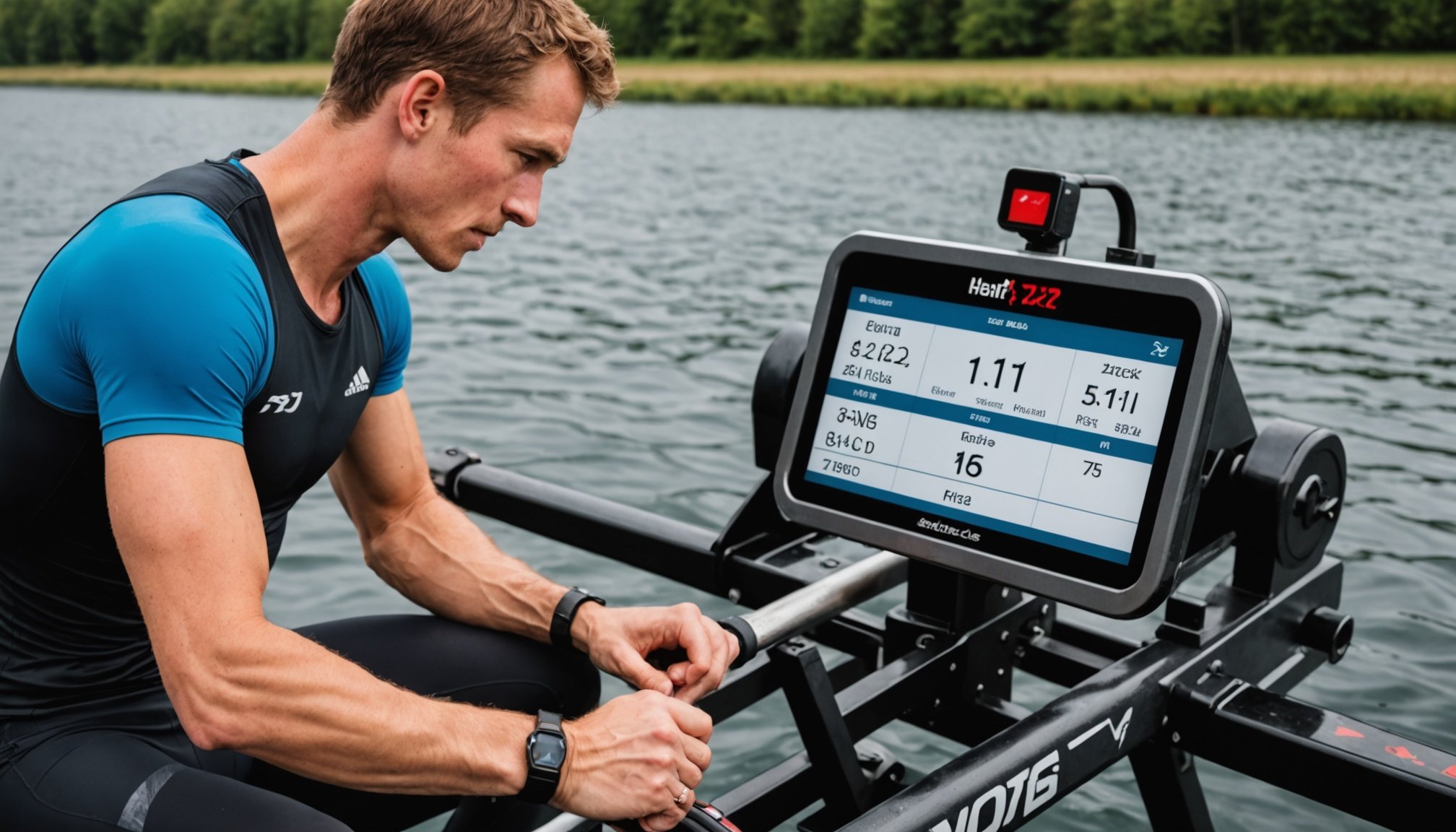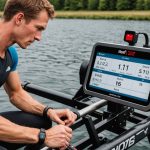Unlock Your Rowing Potential: Harnessing Heart Rate Monitoring for Superior Training
Why Heart Rate Monitoring Matters in Rowing
When it comes to optimizing your rowing performance, understanding and monitoring your heart rate is crucial. Heart rate monitoring allows you to gauge your intensity levels, ensure you stay within specific training zones, and prevent overtraining. Here’s why heart rate monitoring is a game-changer for rowers:
Understanding Your Heart Rate Zones
Heart rate zones are the cornerstone of effective training. These zones are typically categorized into five levels, each corresponding to a different intensity of exercise:
Also to discover : Enhancing Aqua Endurance: Key Strategies for Synchronized Swimmers
- Zone 1: Recovery – This is the lightest zone, where you’re just getting your body moving. It’s ideal for warm-ups and cool-downs.
- Zone 2: Endurance – Here, you’re working at a moderate intensity, which is great for building cardiovascular endurance.
- Zone 3: Tempo – This zone is for more intense workouts, where you’re pushing your limits but can still maintain a conversation.
- Zone 4: Lactate Threshold – At this level, you’re working very hard and can only manage short bursts of conversation.
- Zone 5: Maximum Effort – This is the highest intensity zone, where you’re giving it your all and can only sustain for short periods.
The Importance of Accurate Heart Rate Data
Accurate heart rate data is essential for zone training. Here’s what you need to know:
- **Chest Strap Heart Rate Monitors**: These use electrodes to measure electrical signals from the heart, providing highly accurate and reliable readings. They are considered the gold standard for heart rate monitoring, especially during high-intensity training sessions[1].
- **Wrist-Based Heart Rate Monitors**: While convenient and useful for general activity tracking, wrist-based monitors using optical sensors can struggle with rapid changes in heart rate, especially during intense workouts. They are also prone to movement interference and require precise wrist placement for accurate readings[1].
Choosing the Right Heart Rate Monitor for Rowing
Selecting the right heart rate monitor can make a significant difference in your training. Here are some key considerations:
This might interest you : Enhancing Aqua Endurance: Key Strategies for Synchronized Swimmers
Pros and Cons of Chest Strap Heart Rate Monitors
- Pros:
- High Accuracy: Chest straps provide more reliable data during both low- and high-intensity workouts.
- Real-Time Feedback: Accurate readings allow for better zone training and conditioning adaptations.
- Affordable Options: Models from brands like Polar and Garmin are available for under $50, making them accessible for most athletes[1].
- Cons:
- Less Comfortable: Wearing a chest strap can be less comfortable compared to wrist-based devices.
- Limited Functionality: Primarily focused on heart rate tracking and does not offer features like daily activity monitoring[1].
Pros and Cons of Wrist-Based Heart Rate Monitors
- Pros:
- Convenience: Easy to wear and integrate with fitness watches.
- 24/7 Tracking: Good for measuring overall strain, daily steps, and sleep patterns[1].
- Cons:
- Accuracy Issues: Optical sensors can struggle with rapid changes in heart rate, especially during high-intensity training.
- Movement Interference: Arm movements during exercises like running or rowing can disrupt readings, mistaking cadence for heart rate[1].
How to Use Heart Rate Monitors in Your Rowing Training
For General Fitness Tracking
- Wrist-based monitors are suitable for daily wear, offering insights into general fitness, recovery, and strain. They are great for tracking your overall activity levels and can provide a good baseline for your fitness[1].
For Conditioning Workouts
- Use a chest strap to accurately monitor heart rate zones. This is particularly important for interval training, zone-specific work, and steady-state cardio. For example, if you’re doing a high-intensity interval training (HIIT) session, a chest strap will ensure you’re accurately staying within your desired heart rate zone[1].
Combining Heart Rate with Wattage
- In some training programs, wattage is used to guide intensity. This approach can eliminate reliance solely on heart rate data, which can fluctuate due to factors like caffeine intake, stress, or temperature. Pairing wattage data with a chest strap can enhance accuracy and effectiveness in training[1].
Practical Tips for Using Heart Rate Monitors
Here are some practical tips to get the most out of your heart rate monitor:
Pairing Your Heart Rate Monitor
- Ensure your heart rate monitor is compatible with your rowing equipment. For instance, the Ergatta rower supports a variety of heart rate monitors, including Polar H9, Polar OH1, Garmin HRM-Dual, and Apple Watch Series 4-8[2][3].
- Follow the pairing instructions carefully. Most chest strap heart rate monitors power on automatically when strapped onto your chest, and you can pair them via the workout set up screen on your rowing device[3].
Maintenance and Care
- For chest straps, regular cleaning is essential. Sweat and salt can damage the rubber straps, leading to dropouts and incorrect readings. Give the strap a wipe down after each use and ensure it is stored properly to extend its lifespan[4].
Real-World Examples and Anecdotes
- Zach Long and Johnny B, from the Performance Plus Programming Podcast, emphasize the importance of accurate heart rate monitoring for conditioning training. They highlight how chest straps outperform wrist-based monitors in high-intensity sessions, ensuring athletes stay within the correct training zones[1].
- Rowers on the Concept2 Forum share their experiences with different heart rate monitors. One user notes that while the Polar H10 is accurate and comfortable, it requires regular maintenance and can be fiddly to keep working correctly. Another user prefers using an arm HR monitor due to the cost and maintenance issues associated with chest straps[4].
Table: Comparing Heart Rate Monitors for Rowing
| Feature | Chest Strap Monitors | Wrist-Based Monitors |
|---|---|---|
| Accuracy | Highly accurate, especially during high-intensity workouts | Less accurate, prone to movement interference and rapid heart rate changes |
| Comfort | Less comfortable, can be bulky | More comfortable, easy to wear |
| Functionality | Primarily heart rate tracking | Includes daily activity, sleep, and other fitness metrics |
| Cost | Affordable options available (e.g., Polar, Garmin) | Generally more expensive, especially for high-end models |
| Compatibility | Compatible with most rowing devices via Bluetooth or ANT+ | Compatible with many rowing devices, but may require specific settings (e.g., Apple Watch SE)[2][3] |
| Maintenance | Requires regular cleaning and strap replacement | Minimal maintenance required |
Quotes from Experts and Athletes
- “Heart rate monitors are essential for understanding physiological responses. Chest straps provide more accurate heart rate data than wrist monitors, which is crucial for optimizing conditioning training.” – Zach Long, Performance Plus Programming Podcast[1].
- “Using heart rate data can help athletes fine-tune workouts, improve efficiency, and prevent overtraining. It’s a key component of effective training programs.” – British Rowing Plus[5].
Heart rate monitoring is a powerful tool for rowers looking to enhance their performance. By understanding the differences between chest strap and wrist-based heart rate monitors, you can make informed decisions about which device best suits your training needs. Here are some final takeaways:
- Accuracy is Key: For high-intensity and zone-specific training, chest strap heart rate monitors are the preferred choice due to their high accuracy.
- Combine with Other Metrics: Pairing heart rate data with wattage or other performance metrics can provide a more comprehensive view of your training intensity.
- Maintenance Matters: Regularly clean and maintain your heart rate monitor to ensure it continues to provide accurate readings.
- Learn Your Zones: Understanding and working within your heart rate zones is essential for effective training and preventing overtraining.
By harnessing the power of heart rate monitoring, you can unlock your full rowing potential, optimize your training sessions, and achieve superior performance in the sport you love.






